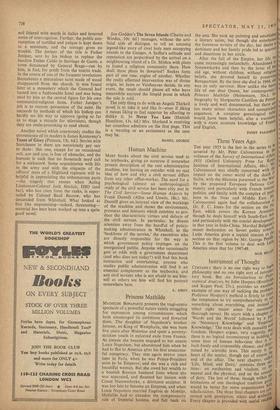Princess Mathilde MATHILDE BONAPARTE presents the tragi-comic spectacle of a
powerful nature vainly struggling for expression among circumstances which both encouraged its ambitions and thwarted them. The daughter of Napoleon's brother Jerome, ex-King of Westphalia, she was born five years after Waterloo and spent a poverty- stricken youth in enforced exile from France. At sixteen she became engaged to her cousin Louis Napoleon, but abandoned him when he had to flee to America 4fter his first unsuccess- ful conspiracy. They met again twelve years later in Paris, when he was Prince-President soon to be Emperor, and she was a rich and beautiful woman. But she owed her wealth to a boorish Russian husband from whom she was separated, and flaunted her liaison with Count Nieuwerkerke, a dilettante sculptor. It was too late to become an Empress, and when Louis Napoleon married Eugenie de Montijo, Mathilde had to abandon the compensatory role of Imperial hostess, and fall back on SPECTATOR, MAY 25, 1,156 the arts. She took up painting and established a literary salon, but though she entertained the foremost writers of the day, her desire lo dominate and her family pride led to quarrels and desertions in her circle. After the fall of the Empire, her life be' came increasingly melancholy. Abandoned Nieuwerkerke and then by the lover of Iler old age, without children, without religious beliefs, she devoted herself to preserviN Bonapartism. By the time she died in 1904, she was its only survivor. How unlike the MO life of our dear Queen, her contemporafY! Princess Mathilde (Heinemann, 30s.), the biography by Marguerite Castillon du Pefr°11' is lively and well documented, but there nre too many minor characters and unexplained sequences. A complete genealogical tl able would have been helpful, also a transInto,r with a more accurate knowledge of Frenclj and English.










































 Previous page
Previous page